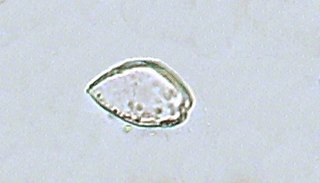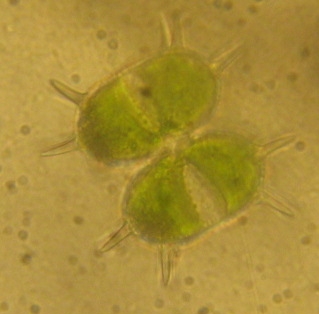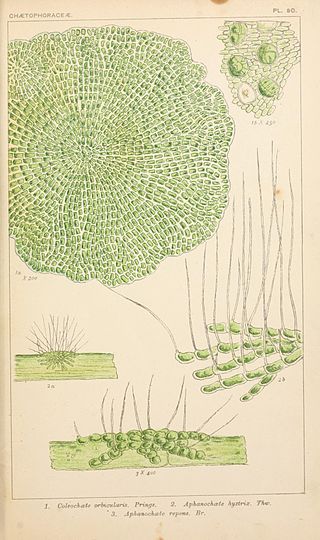
The Prorocentrales are a small order of dinoflagellates. They are distinguished by having their two flagella inserted apically, rather than ventrally as in other groups. One flagellum extends forward and the other circles its base, and there are no flagellar grooves. This arrangement is called desmokont, in contrast to the dinokont arrangement found in other groups. Accordingly, the Prorocentrales may be called desmoflagellates, and in some classifications were treated as a separate class Desmophyceae.

The glaucophytes, also known as glaucocystophytes or glaucocystids, are a small group of unicellular algae found in freshwater and moist terrestrial environments, less common today than they were during the Proterozoic. The stated number of species in the group varies from about 14 to 26. Together with the red algae (Rhodophyta) and the green algae plus land plants, they form the Archaeplastida.

The cryptophyceae are a class of algae, most of which have plastids. About 230 species are known, and they are common in freshwater, and also occur in marine and brackish habitats. Each cell is around 10–50 μm in size and flattened in shape, with an anterior groove or pocket. At the edge of the pocket there are typically two slightly unequal flagella.

Ankistrodesmus is a genus of green algae in the family Selenastraceae. It is one of the most common types of phytoplankton in freshwater habitats around the world.
Trichosarcina is a genus of green algae in the order Ulotrichales. Filoprotococcus was once regarded as a synonym. However, Filoprotococcus is now considered valid in its own right. Trichosarcina is considered to be of uncertain validity.

Xanthidium is a genus of green algae, specifically of the Desmidiaceae.
The Mesostigmatophyceae are a class of basal green algae found in freshwater. In a narrow circumscription, the class contains a single genus, Mesostigma. AlgaeBase then places the order within its circumscription of Charophyta. A clade containing Chlorokybus and Spirotaenia may either be added, or treated as a sister, with Chlorokybus placed in a separate class, Chlorokybophyceae. When broadly circumscribed, Mesostigmatophyceae may be placed as sister to all other green algae, or as sister to all Streptophyta.
Mesostigma is a genus of unicellular biflagellate freshwater green algae, with a single species Mesostigma viride, covered by an outer layer of basket‐like scales instead of a cell wall. AlgaeBase classifies it as the only genus in the family Mesostigmataceae, the only family in the order Mesostigmatales, the only order in the class Mesostigmatophyceae. It is now considered to be one of the earliest diverging members of green plants/algae (Viridiplantae).

Coleochaetaceae is a family of algae. It is the only family in the Coleochaetales, an order of parenchymous charophyte algae, that includes some of the closest multicellular relatives of land plants. They questionably include the fossil genus Parka.
Filoprotococcus is a genus of green algae in the order Ulotrichales. It was once regarded as a synonym of Trichosarcina. However, it is now accepted as a genus in its own right, and Trichosarcina is considered taxonomically uncertain.

Rhodomonas is a genus of cryptomonads. It is characterized by its red colour, the square-shaped plates of its inner periplast, its short furrow ending in a gullet, and a distinctly shaped chloroplast closely associated with its nucleomorph. Historically, Rhodomonas was characterized by its red chloroplast alone, but this no longer occurs as its taxonomy has become increasingly based on molecular and cellular data. Currently, there is some debate about the taxonomic validity of Rhodomonas as a genus and further research is needed to verify its taxonomic status. Rhodomonas is typically found in marine environments, although freshwater reports exist. It is commonly used as a live feed for various aquaculture species.

The Chlorophytina are a proposed basal Tetraphytina clade. It is currently seen as sister of the Pedinomonadaceae. It contains the more well-known green alga and is characterized by the presence of phycoplasts.

Pyrenomonadaceae is a family of cryptomonads which includes three or four known genera. They are distinguished from other cryptomonads by their nucleomorphs being imbedded into the pyrenoid, and the presence of distinctive pigment phycoerythrin 545.






